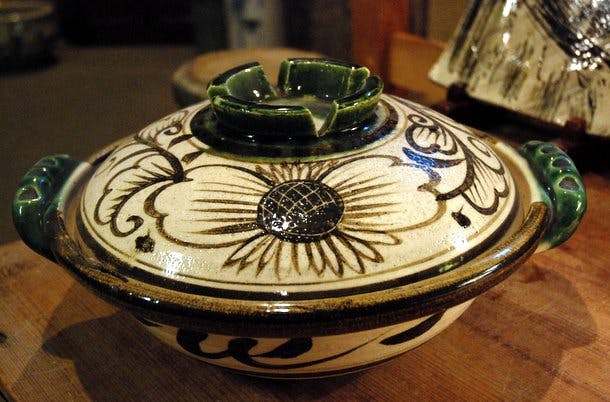
iga donabe maker
Explore the history and craftsmanship of traditional Japanese cooking vessels known as donabe. Visit Iga village in Mie Prefecture where Iga Mono, the last major donabe company, continues the 175-year tradition of producing these prized earthenware pots. Learn about the unique Biwakoso clay, known for its exceptional heat retention and insulating properties, that makes Iga donabe a staple in Japanese kitchens.
Before I left New York, Chef Tadashi Ono, my sensei at Matsuri Restaurant, gave me my marching orders: "Bring me back a donabe, man."
At one time you could find a traditional donabe in every Japanese kitchen, heavy earthenware cooking vessels used for everything from roasting green tea to preparing rice. And at one time there were dozens of donabe makers in the vicinity of Iga village in Mie Prefecture, where the finest of these vessels are produced.
Today there's just one major donabe company left here, called Iga Mono, run by the same family for 175 years. I paid a visit to the 8th generation owner, Mr. Nagatani, to learn more about the vessels. And to make the chef happy, of course.
A couple of friends, who are always up for an adventure, drove me to Iga. As we approached Mr. Nagatani's compound I was struck by the scale of the industry: A dozen workshops and warehouses rising from a valley of rice fields in this deeply rural corner of the country. As Mr. Nagatani graciously walked us around I was struck by another sight, too: A monstrous sixteen chambered, wood-fired, packed-earth kin that snaked up a hillside for a hundred yards. "Built in 1835," Mr. Nagatani said. "And fired until 1970, when it was replaced by gas-powered equipment." Countless donabe born in its chambers.
We walked into one of the workshops and watched artisans form, shape and glaze donabe to ready them for the kiln. Why Iga, I wondered? Why does this place make such prized vessels?
Mr. Nagatani pointed to a donabe waiting to be fired. "This clay," he said, by way of answer. Biwakoso clay -- old Biwa clay. Millions of years ago, he explained, the valley where we stood was submerged under nearby Lake Biwa, Japan's largest. As a result, the clay found here -- clay that was once lakebed mud -- is impregnated with microscopic remains of water creatures and plant life. When this material is fired, the organic matter inside burns up and, in its place, tiny air pockets remain -- giving the thick walls of Iga donabe peerless heat retention and insulating properties. In other words, the prefect clay to make a donabe that heats quickly and stays warm for a long time.
Mr. Nagatani explained that his company made over a thousand specialized kinds of donabe over the years. Today he still manufactures more than two dozen kinds, each handcrafted and fired in a giant gas kiln the size of a hotel room (at least the budget hotel rooms I'm staying in these days!). He showed me a yukihara, the oldest shape, for cooking rice porridge, a shallow horakunabe for roasting and a deep fukanabe for slow cooking. I bought two for the chef and three for me (sorry, chef!). Mission accomplished.
By the time we walked outside, night was approaching. The country air was cool and fresh. The sky was painted grey-blue and rose. A crescent moon loomed. Long, piscine-shaped clouds streaked across the darkening horizon. "We call them 'sardine clouds' here in Japan," one of my friends told me. A good omen, I thought.
